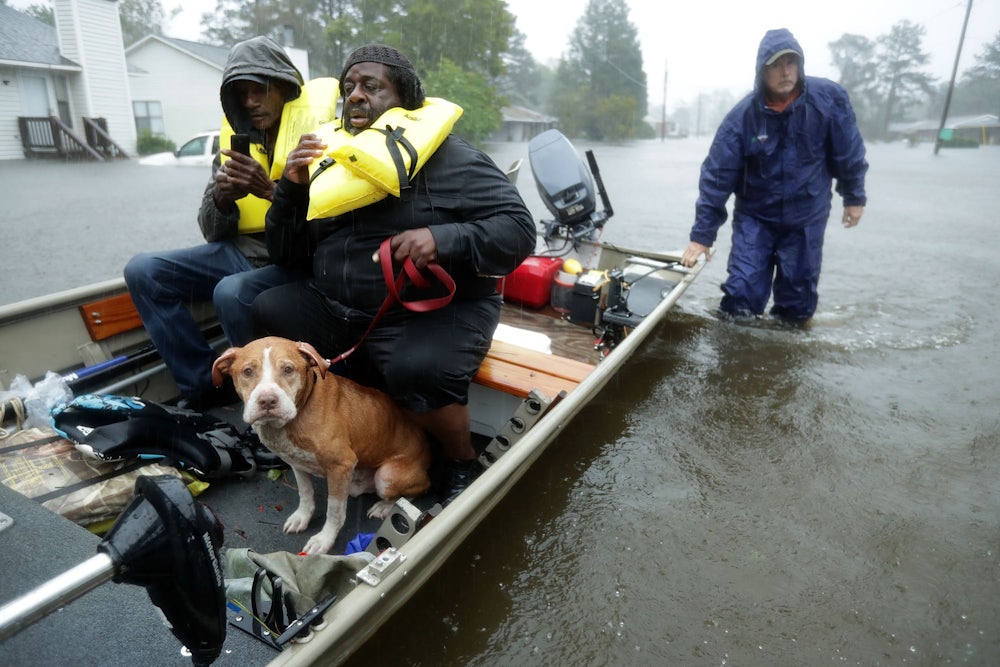Before he left for North Carolina on Wednesday to survey damage caused by Hurricane Florence, President Donald Trump released a video celebrating his administration’s response. “This is a tough hurricane,” he said, “one of the wettest we’ve ever seen, from the standpoint of water.”* The sentiment, though redundant, was correct. Florence was the rainiest hurricane on record for the Carolinas, and the eighth-rainiest to ever hit the contiguous United States.
Florence is still a tough hurricane, even though it has dissipated and moved out into the Atlantic. Thousands are still in immediate danger due to flooding caused by overflowing rivers, some of which have yet to reach their highest point. For those people, Florence is an ongoing disaster that may only get tougher in the coming days. Rivers were still rising in North Carolina on Tuesday, and in South Carolina are expected to continue rising throughout the week.
You can clearly see the water levels rising in Cape Fear River as we compare photos from Sunday to Today. #capefear #Florence #ReadyNC #ReadyFay pic.twitter.com/jiPUCVpLBP
— Fayetteville Police (@FayettevillePD) September 18, 2018
Hurricane Florence’s physical dangers, however, aren’t the only things contributing to its continued destructive force. Miscommunication about the storm has abounded, causing people to make unsafe decisions they may have otherwise avoided.
As Florence approached the Carolina coastline, forecasters noted it had weakened from a Category 4 to a Category 1 storm. This prompted many people to cancel their evacuation plans. “[We] didn’t think it was actually going to be as bad,” North Carolina corrections officer Famous Roberts told the Associated Press.
They were wrong, but they weren’t wrong because the forecasters were wrong. They were wrong because the Saffir-Simpson scale, as the hurricane ranking system is known, only measures hurricane danger in terms of wind speed; it doesn’t take excessive rainfall, storm surge, or the potential for river overflows into account. Americans react accordingly. When preparing for a hurricane, we expect a one- or two-day impact of wind damage, and perhaps some rain and storm surge, before it eventually passes. We don’t expect slow-moving rainstorms like Florence that overflow inland river systems.
The reality is that wind and storm surge are only one part of a hurricane—what University of Georgia meteorologist Marshall Shepherd has called “Phase A.” In a piece for Forbes last week, he argued there’s a lack of public understanding around “Phase B,” the “slow-moving to stalled weakened storm with a lot of rainfall.” Florence has had a particularly dangerous Phase B. So did Hurricane Harvey, which tortured Houston, Texas, with slow-moving rainfall and life-threatening flooding last year.
#Florence is a "Category 5 flood threat," @weatherchannel smartly says. The rainfall forecast remains astronomical. More: https://t.co/4lRd16vBoS pic.twitter.com/RIN0Wt3ExR
— Capital Weather Gang (@capitalweather) September 13, 2018
It’s essential that the public be aware of Phase B because such extreme rainfall is becoming more likely. “For every degree Celsius of [global] warming, water vapor in the atmosphere increases by 7 percent,” said Kate Marvel, a climate scientist at Columbia University and NASA. “We’re as sure that climate change means rainier storms as we are that smoking causes cancer.” Phase B is also arguably the more deadly part of a hurricane. According to one major study, only 11 percent of hurricane fatalities are due to wind or embedded tornadoes. The rest are caused by water: ocean storm surge and high surf, for instance, but more importantly inland flooding, which accounts for 55 percent of all deaths.
Some solution-oriented discussion has already begun, such as changing or replacing the Saffir-Simpson scale. “It should definitely be modified to have some factors, including not only wind, but also flooding and maximum storm surge height, or amount of rainfall,” said Irwin Redlener, the director of the National Center for Disaster Preparedness. Others aren’t convinced. “[The scale] provides value on the information it as intended for and is useful for historical context or scientific studies,” Shepherd wrote.
Instead, Shepherd suggested forecasters be more frank about the limitations of the Saffir-Simpson scale. “Meteorologists must continue to hammer home the message that inherent dangers of hurricanes like Florence are not completely captured by the scale,” he said. “A simple reminder that Hurricane Sandy was not really even a Category 1 storm when it devastated the northeast United States usually gives people perspective.” The public also has to start listening, he said; many forecasters have been talking about these limitations for years.
But solving the miscommunication problem posed by Florence may require something bigger than changing one meteorological tool. It could require changing how to refer to slow-moving, rain-heavy hurricanes in the first place. Redlener suggested “water disaster.” But whatever the solution, he said, “There are significant reasons to start rethinking how we understand the consequences of large natural disasters.” The main reason being that more are on the way.
*Correction: A previous version of this story stated that Trump used the past tense in referring to Hurricane Florence. He used the present tense.
